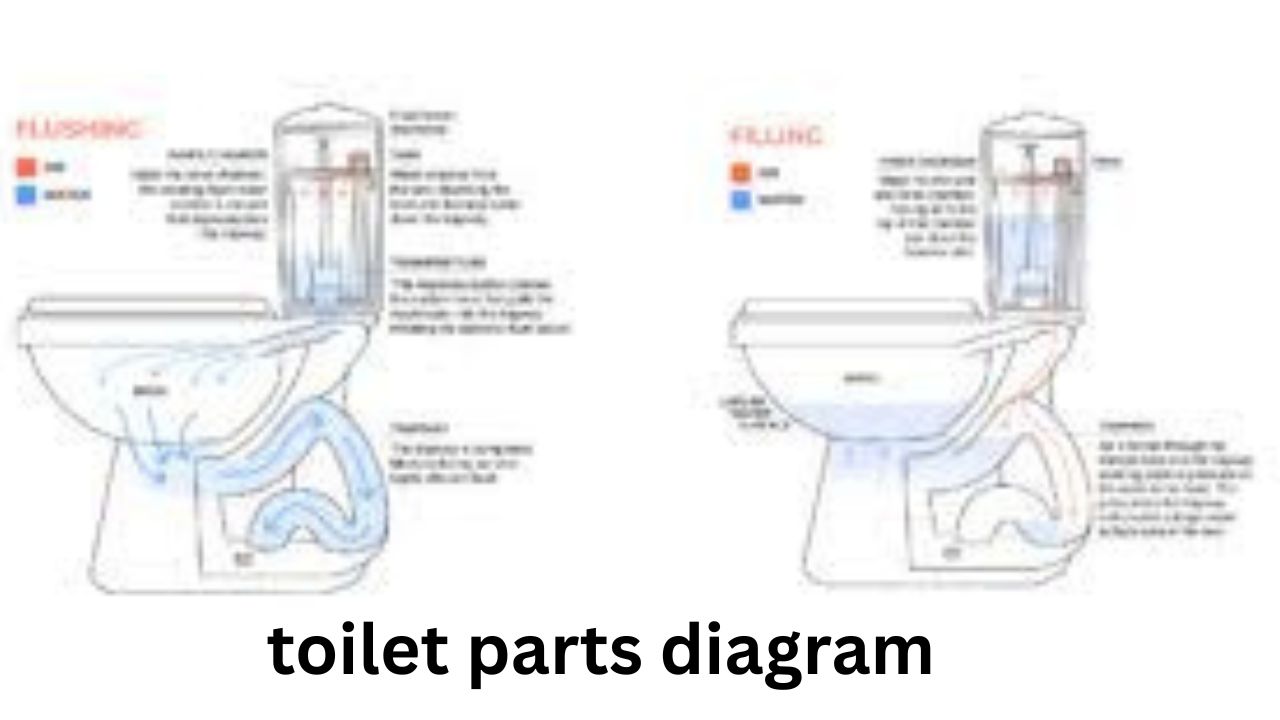Let’s face it—toilets aren’t something we spend much time thinking about… until they stop working.
Maybe your toilet keeps running like it’s training for a marathon. Or maybe there’s an odd leak, a strange noise, or your flush just isn’t cutting it. If you’ve been there (and let’s be honest, most of us have), you’ve probably asked yourself:
“What even is that part inside the tank?”
“Is that little flappy thing broken?”
“Do I really need a plumber for this?”
Well, take a deep breath—you don’t need to feel lost anymore. This guide is your friendly, down-to-earth answer to all those toilet mysteries. We’re going to walk you through everything step by step using easy language, handy images (coming later!), and diagrams that make sense.
But first—why should you care about knowing the toilet parts diagram in the first place?
Why It’s Smart to Know What’s Inside Your Toilet
You don’t need to be a plumber to understand how your toilet works. Trust me, learning just a little about it can:
- Save you money – No more unnecessary service calls.
- Save you stress – You’ll know what’s wrong and how to fix it.
- Help in emergencies – Know how to stop leaks or overflows fast.
- Give you confidence – Because honestly, you can fix more than you think.
Imagine this: a tiny leak starts one evening, and instead of freaking out, you grab your handy guide and say, “Ah, it’s the flapper! I got this.” That’s power.
Understanding your toilet diagram puts you in control. It’s not just for plumbers or handymen—it’s for you, the everyday homeowner or renter who wants a smooth-running bathroom and a little peace of mind.
What’s in a Toilet Anyway?
Let’s break it down with no fluff and no confusion.
Your toilet isn’t just a seat and a flush handle. It’s actually a clever system with parts working together to get one job done: moving waste cleanly and efficiently down the drain.
Now, throughout this guide, you’re going to see plenty of diagrams. These will include things like:
- A toilet tank diagram labeled (the stuff hidden behind the lid)
- A toilet bowl parts diagram (everything you sit on and see)
- A toilet part diagram showing names and locations
- A toilet diagram fill valve explaining how water flows in
- A diagram toilet parts names cheat sheet for quick ID
And yes—we’re even throwing in some cool ones like:
- Toto toilet parts diagram
- Kohler toilet tank parts diagram
- Glacier Bay power flush toilet parts diagram
Why? Because different brands have different designs. But don’t worry—they all work in similar ways.
What You Can Fix Yourself (And Feel Like a Hero Doing It)
Believe it or not, a lot of common toilet problems are totally fixable without hiring anyone. You just need a little knowledge and maybe a screwdriver or wrench.
Here are some simple things you’ll be able to fix after reading this guide:
- Adjusting the fill valve when your toilet won’t stop filling
- Replacing a broken flapper (super common!)
- Tightening bolts to stop a leaky base
- Understanding what to do when the toilet doesn’t flush
- Installing a toilet flange when replacing the whole toilet
We’ll even explain things like toilet flange installation diagram step-by-step with visuals. So yeah—you’ve got this!
What to Expect in This Guide (Diagrams Galore!)
This isn’t just a wall of words. Nope—we’re giving you the works:
Toilet diagrams you can actually understand
Toilet pipeline diagram to see where waste goes
Toilet pipe diagram showing how everything connects
Toilet trap diagram so you can spot clogs before they get gross
Toilet pipework diagram with labeled inlets and outlets
Toilet plumbing diagrams for both beginners and DIY pros
Want more? You’ll also find:
- Toilet installation diagram (for new setups)
- Toilet drain pipe diagram (where the water and waste go)
- Diagram of a toilet drain (you’ll love this visual)
- Toilet plumbing rough-in diagram (where pipes go in the wall)
- Toilet plumbing rough in diagram (yes, same term, slightly different spelling!)
- Back to back toilet plumbing diagram (used in shared bathrooms)
We’ll even make venting clear with:
- Toilet vent diagram
- Toilet vent pipe diagram
- Toilet plumbing vent diagram
- Toilet plumbing venting diagram
- Venting toilets diagrams
- Toilet vent stack diagram
Most of these aren’t even covered properly by other sites, but you will get the full scoop.
A Real-World Example (Let’s Paint the Picture)
You’ve just moved into a new place. The bathroom looks fine… until you hear a weird “drip… drip…” inside the tank. You pop the lid and stare at what looks like spaghetti made of plastic and metal.
“What is all this?!”
That’s where our toilet components diagram saves the day. You’ll be able to say, “Oh, that’s just the fill valve leaking. Easy fix.”
Or maybe you’re helping Grandma install grab bars in the bathroom and don’t know the right placement? No problem—we’ll include a toilet grab bar placement diagram too.
Whether you’re dealing with old homes, new builds, or fancy toilets with extra buttons, we’ve got the tools to help.
Toilets May Look Different, But They All Follow the Same Rules
Whether you’re working with a traditional round toilet or a sleek, modern model, every toilet has:
- A tank to hold water
- A bowl to catch waste
- Pipes to flush and drain
- Vents to keep things flowing
- Parts inside to make it all happen
That’s where understanding your toilet diagrams becomes so helpful. It’s like a map to plumbing peace.
Who Needs This Guide?
You do—if you’re…
- A homeowner who wants fewer plumber visits
- A renter responsible for basic repairs
- A DIY enthusiast looking to level up your skills
- A parent teaching your kid how to fix things
- A new homeowner unsure what that gurgling sound means
- Someone who just wants to stop flushing money down the… well, you get it
Ready to Dive In?
We’re just getting started. Up next, we’ll look at different types of toilets and their parts, so you’ll be ready for anything from a classic porcelain throne to a water-saving dual flush model.
By the end of this guide, you’ll be the go-to person in your home when the toilet acts up. You won’t just know what’s broken—you’ll know what to do.
Because when you understand your toilet, you’re not just fixing a problem… you’re taking back control.
Types of Toilets and Their Basic Anatomy
Hey there! Now that you’ve got a good idea about the toilet parts diagram, let’s go a little deeper. Have you ever wondered why some toilets look different than others? Or why one flushes with a whoosh and another with a gurgle? That’s because there are different types of toilets, and each has its own special parts and layout.
Let’s explore these types of toilets and break down their basic anatomy in a way that’s easy and fun to understand!
1. The Two Main Toilet Types: Gravity-Flush vs. Pressure-Assisted
Gravity-Flush Toilets
This is the most common type you’ll find in homes. It works with simple water pressure. When you flush, water from the toilet tank flows into the toilet bowl, pushing everything down the toilet drain pipe using gravity. Think of it as nature’s power helping you clean the bowl!
You’ll find these often in Kohler toilet tank parts diagrams or Toto toilet parts diagrams because they’re popular models.
Pressure-Assisted Toilets
These use air pressure and are often found in public bathrooms. They’re loud but powerful. Brands like Glacier Bay power flush toilet parts diagrams usually show this setup. They need more parts, and their toilet tank diagram labeled might include an extra pressure vessel inside the tank.
2. One-Piece vs. Two-Piece Toilets
- One-piece toilets: These have the tank and bowl molded into a single unit. They’re sleek and easy to clean.
- Two-piece toilets: The tank and bowl are separate but connected. Most homes have this type because it’s more affordable and easier to replace.
You’ll often find both types in any toilet installation diagram or toilet plumbing diagrams.
3. Wall-Mounted vs. Floor-Mounted Toilets
- Wall-mounted toilets: These are attached to the wall, and the tank is hidden behind it. You usually see these in fancy hotels or modern homes.
- Floor-mounted toilets: These are the regular ones that sit on the floor. They’re easier to install and service.
The toilet flange installation diagram comes into play here—it shows how the toilet connects to the floor or wall using a toilet flange, which is a pipe fitting that keeps things sealed tight.
4. The Basic Parts of Every Toilet (A Quick Tour!)
Every toilet may look a little different, but deep down, they all have the same important parts. Let’s look at what’s usually found in a toilet components diagram or diagram toilet parts names.
The Toilet Bowl
This is where the “magic” happens. It’s the part you sit on. You’ll see it clearly in a toilet bowl parts diagram or a diagram of a toilet bowl.
The Toilet Tank
This holds the water that flushes the toilet. If you peek inside, you’ll find:
- Fill valve: This lets water refill the tank. Look for it in the toilet diagram fill valve section.
- Flush valve: This opens to let water into the bowl.
- Flapper: A rubber seal that lifts up when you flush.
- Float: A small balloon-like device that tells the fill valve when the tank is full again.
You’ll see all these in a detailed toilet tank diagram labeled or a toilet part diagram.
5. What About the Pipes?
Now this part is super important. Every toilet needs to connect to plumbing correctly so everything goes where it should.
Toilet Drain Pipe
This is the big pipe under the toilet bowl. It carries everything away after you flush. You’ll find it in the diagram of a toilet drain, toilet pipe diagram, and toilet pipeline diagram.
Toilet Trap
This is a curved pipe right under the bowl. It holds water to block bad smells from coming back up. It’s shown clearly in the toilet trap diagram.
6. Venting the Toilet – So Important!
Toilets also need air to work properly! That’s where toilet vent diagrams come in.
Why Do Toilets Need Vents?
Think of it like this: without air, your soda doesn’t fizz. Without vents, your toilet doesn’t flush right.
The toilet vent diagram, toilet vent pipe diagram, and toilet plumbing vent diagram all show how air flows through pipes to let water drain easily.
If you’re venting a toilet diagram or checking venting toilets diagrams, you’ll see pipes going up and out to the roof. This lets the air escape.
Some houses even use a toilet vent stack diagram. That’s a big vertical pipe that connects all the vents together and sends sewer gas far away.
7. Rough-In Plumbing Basics
If you’re building or remodeling, you’ll need to look at the toilet plumbing rough-in diagram. It tells you how far the toilet flange should be from the wall and where the pipes go.
There’s also the toilet plumbing rough in diagram (yes, with or without the dash!) which includes:
- Drain pipe position
- Water supply line
- Vent pipe location
These diagrams are like blueprints for your bathroom.
8. Special Toilets – Yes, They Exist!
Accessible Toilets
Ever heard of toilet grab bar placement diagrams? These show where safety bars should go so people with disabilities can use the toilet easily and safely.
Back-to-Back Toilets
Sometimes two toilets share the same wall (like in duplex homes). The back to back toilet plumbing diagram shows how to connect them without mixing things up!
9. Diagrams That Help You Understand Toilets
There are lots of visual guides that show you how a toilet works. Some of the most helpful ones include:
- Toilet diagrams (general overview)
- Toilet diagram parts (specific pieces labeled)
- Toilet pipework diagram (focuses on plumbing)
- Toilet part diagram (internal mechanics)
- Toto toilet parts diagram and Kohler toilet tank parts diagram (brand-specific breakdowns)
These diagrams help you see everything—whether you’re a DIYer, a homeowner, or just curious!
10. Wrapping It Up: Why This All Matters
Understanding your toilet isn’t just for plumbers. Knowing the toilet components diagram or spotting a part in the toilet diagram fill valve can help you fix little issues yourself, save money, and even plan your bathroom renovation better.
Whether you’re checking the toilet pipeline diagram, or comparing a toilet diagram with real parts in your bathroom, you’re learning how something essential in your home works.
Phew! That was a lot, but now you know all about the different types of toilets and how their basic anatomy works—from the flush valve to the toilet vent stack diagram.
Next up, we’ll go deeper into toilet plumbing systems and show how everything connects behind the scenes.




